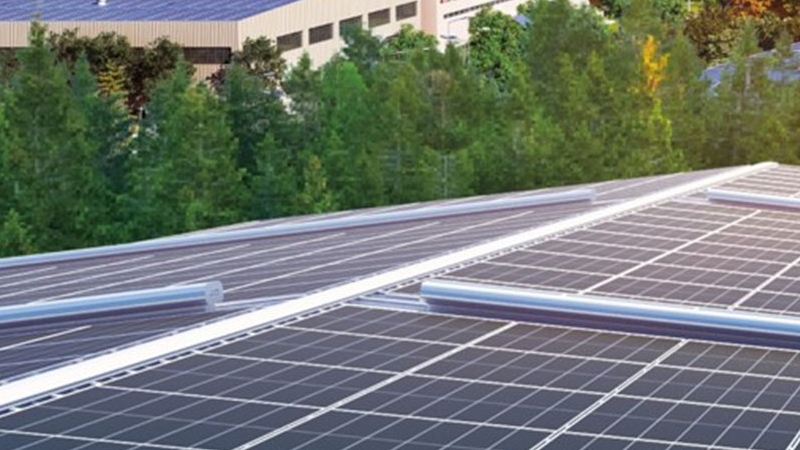分布式光伏发电是什么,有什么特点?
分布式光伏发电是一种就近利用太阳能资源进行发电的模式,主要依托建筑物屋顶、空地等场地布设光伏组件,所发电量优先满足本地用电需求,多余电量可并入公共电网,具有就近消纳、减少线损的特点,是清洁能源利用的重要形式。
Distributed photovoltaic power generation is a mode of generating electricity by utilizing solar energy resources nearby, mainly relying on the installation of photovoltaic modules on building roofs, open spaces and other sites. The generated electricity prioritizes meeting local electricity demand, and excess electricity can be integrated into the public grid. It has the characteristics of nearby consumption and reducing line losses, and is an important form of clean energy utilization.
其工作原理基于光生伏特效应:光伏组件中的半导体材料吸收太阳光能后,产生电子 - 空穴对,在电场作用下形成电流,经汇流箱汇集后,由逆变器将直流电转换为交流电,供家庭、企业等直接使用。若发电功率超过实时用电需求,剩余电力通过计量装置送入电网;若光照不足导致发电量不足,可从电网取用补充,实现灵活互补。
Its working principle is based on the photovoltaic effect: the semiconductor materials in photovoltaic modules absorb solar energy and generate electron hole pairs, which form an electric current under the action of an electric field. After being collected by a combiner box, the direct current is converted into alternating current by an inverter for direct use in households, enterprises, etc. If the generated power exceeds the real-time electricity demand, the surplus electricity is sent to the grid through a metering device; If insufficient lighting leads to insufficient power generation, it can be supplemented from the power grid to achieve flexible complementarity.
从系统组成来看,分布式光伏发电系统主要包括光伏组件、逆变器、汇流箱、支架及计量装置。光伏组件是核心发电部件,单块功率通常在 300-500 瓦,通过串联或并联形成阵列;逆变器负责交直流转换,需具备防孤岛保护功能;支架用于固定组件,需根据安装场地选择材质,确保抗风、抗雪能力;计量装置则记录发电量与上网电量,作为电费结算依据。
From the perspective of system composition, distributed photovoltaic power generation systems mainly include photovoltaic modules, inverters, combiner boxes, brackets, and metering devices. Photovoltaic modules are the core power generation components, typically with a single power of 300-500 watts, and are arranged in series or parallel to form an array; The inverter is responsible for AC/DC conversion and needs to have anti islanding protection function; The bracket is used to fix components, and the material should be selected according to the installation site to ensure wind and snow resistance; The measuring device records the amount of electricity generated and the amount of electricity connected to the grid as the basis for settling electricity bills.

适用场景广泛,涵盖城乡各类建筑与场地。城市中,居民屋顶可安装户用光伏系统,满足家庭日常用电;工商业厂房的大面积屋顶适合建设较大规模项目,为生产设备供电,降低企业用电成本。农村地区,闲置宅基地、大棚顶部可布设光伏组件,既不影响土地耕作,又能为农业灌溉设备供电;偏远地区的无电村落,可通过独立式分布式光伏解决基本用电问题,减少对柴油发电机的依赖。此外,公共建筑的屋顶与停车场遮阳棚也可安装光伏系统,兼顾发电与遮阳功能,提升能源利用效率。
Widely applicable scenarios, covering various types of buildings and sites in urban and rural areas. In cities, residential roofs can be equipped with household photovoltaic systems to meet daily household electricity needs; The large-scale roofs of industrial and commercial plants are suitable for constructing large-scale projects, providing power for production equipment and reducing the cost of electricity for enterprises. In rural areas, unused homesteads and greenhouse roofs can be equipped with photovoltaic modules, which not only do not affect land cultivation but also provide power for agricultural irrigation equipment; Remote villages without electricity can solve basic electricity problems and reduce dependence on diesel generators through independent distributed photovoltaics. In addition, photovoltaic systems can also be installed on the roofs of public buildings and sunshades in parking lots to balance power generation and shading functions, improving energy efficiency.
相比传统集中式发电,分布式光伏发电具有多重优势。能源利用更高效:发电点靠近用电点,减少电力传输过程中的损耗;环保效益显著:每发 1 千瓦时电可减少约 0.9 千克二氧化碳排放,一个 5 千瓦的家庭光伏系统年减排量相当于植树 200 棵;经济性逐步提升:随着光伏组件成本下降,户用系统投资回收期已缩短至 5-8 年,且可享受电价补贴与上网电费收益;灵活性强:可根据用电需求灵活调整装机容量,后期还能扩容。
Compared to traditional centralized power generation, distributed photovoltaic power generation has multiple advantages. More efficient energy utilization: the power generation point is close to the electricity consumption point, reducing losses during power transmission; Significant environmental benefits: for every 1 kilowatt hour of electricity generated, about 0.9 kilograms of carbon dioxide emissions can be reduced, and the annual emission reduction of a 5 kilowatt household photovoltaic system is equivalent to planting 200 trees; Economic efficiency is gradually improving: With the decrease in the cost of photovoltaic modules, the investment payback period for household systems has been shortened to 5-8 years, and they can enjoy electricity price subsidies and grid electricity fee benefits; Strong flexibility: The installed capacity can be flexibly adjusted according to electricity demand, and can be expanded in the later stage.
日常维护需注意以下要点。定期清洁光伏组件表面,去除灰尘、树叶等遮挡物,清洁时使用软布与清水,避免硬物划伤玻璃。检查支架与接线是否松动,确保组件安装牢固,接线端子无氧化。逆变器需保持通风良好,定期查看运行状态指示灯。对于并网系统,需配合电网公司进行定期安全检测,确保符合并网规范,避免影响电网稳定。
Daily maintenance should pay attention to the following points. Regularly clean the surface of photovoltaic modules to remove dust, leaves, and other obstructions. Use a soft cloth and clean water during cleaning to avoid scratching the glass with hard objects. Check whether the bracket and wiring are loose, ensure that the components are installed firmly, and that the wiring terminals are not oxidized. The inverter needs to maintain good ventilation and regularly check the operating status indicator lights. For grid connected systems, it is necessary to cooperate with the power grid company to conduct regular safety inspections to ensure compliance with grid connection standards and avoid affecting grid stability.
本文由分布式光伏发电情奉献.更多有关的知识请点击:http://www.zdnygf.com我们将会对您提出的疑问进行详细的解答,欢迎您登录网站留言.
This article is a friendly contribution from distributed photovoltaic power generation For more information, please click: http://www.zdnygf.com We will provide detailed answers to your questions. You are welcome to log in to our website and leave a message
新闻推荐
product recommendation联系方式
Contact Information

 TEL:0531-82390078
TEL:0531-82390078 TEL:18805312017
TEL:18805312017 MAI:sdzdny001@163.com
MAI:sdzdny001@163.com 公司地址: 济南市历下区山大路157号
公司地址: 济南市历下区山大路157号 天合蓝天·山东种电
天合蓝天·山东种电 备案号:鲁ICP备17052940号-2
鲁公网安备37010202700164号
备案号:鲁ICP备17052940号-2
鲁公网安备37010202700164号
 网站地图|XML|TXT
网站地图|XML|TXT

扫一扫方便咨询我们

截屏,微信识别二维码
微信号:18805312017